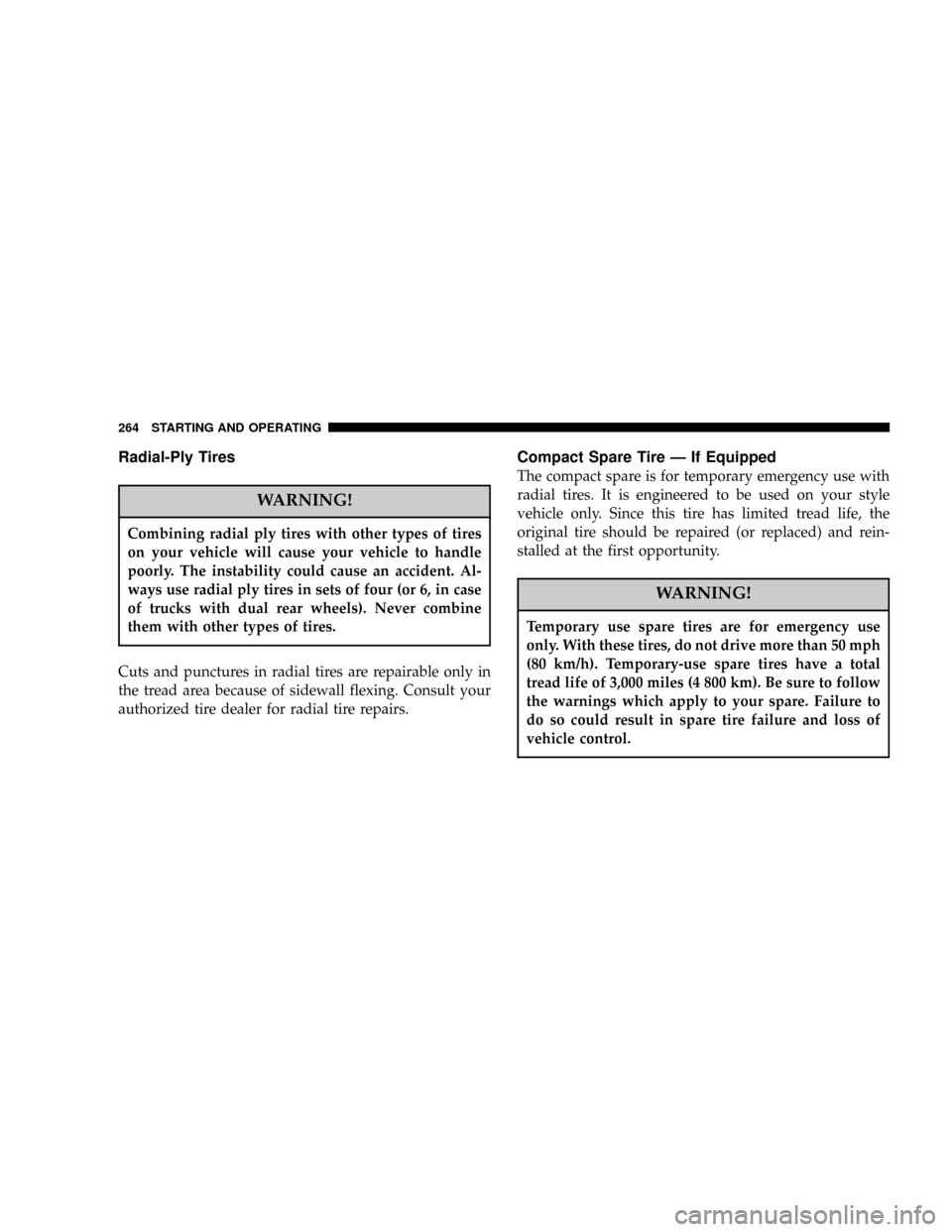Page 74 of 401

WARNING!
If you are required to drive with the liftgate open,
make sure that all windows are closed, and the
climate control blower switch is set at high speed.
DO NOT use the recirculation mode.
Safety Checks You Should Make Inside The
Vehicle
Seat Belts
Inspect the belt system periodically, checking for cuts,
frays and loose parts. Damaged parts must be replaced
immediately. Do not disassemble or modify the system.
Front seat belt assemblies must be replaced after a
collision. Rear seat belt assemblies must be replaced after
a collision if they have been damaged (bent retractor, torn
webbing, etc. If there is any question regarding belt or
retractor condition, replace the belt.
Airbag Light
The light should come on and remain on for 6 to 8
seconds as a bulb check when the ignition switch is first
turned ON. If the LED is not lit during starting, have it
checked. If the light stays on or comes on while driving,
have the system checked by an authorized dealer.
Defroster
Check operation by selecting the defrost mode and place
the blower control on high speed. You should be able to
feel the air directed against the windshield.
Periodic Safety Checks You Should Make Outside
The Vehicle
Tires
Examine tires for excessive tread wear or uneven wear
patterns. Check for stones, nails, glass, or other objects
lodged in the tread. Inspect tread and sidewall for cuts or
cracks. Check wheel nuts for tightness, and tires (includ-
ing spare) for proper pressure.
74 THINGS TO KNOW BEFORE STARTING YOUR VEHICLE
Page 125 of 401

Electronic Vehicle Information Center (EVIC) Ð If
Equipped
The Electronic Vehicle Information Center, when the
appropriate conditions exist, displays the following
WARNING messages and symbols. Each message is
accompanied by a single chime:
²TURN SIGNALS ON (with graphic)
²PERFORM SERVICE
²DOOR AJAR (one or more, with graphic)
²LIFTGATE AJAR (with graphic)
²WASHER FLUID LOW (with graphic)
²1,2,3 OR 4 LOW TIRE(S) PRESSURE (Refer to ªStarting
And Operating, Tire Sectionº)
²1,2,3 OR 4 HIGH TIRE(S) PRESSURE (Refer to ªStart-
ing And Operating, Tire Sectionº)
²SERVICE TIRE PRESS. SYSTEM/SEE OWNER'S
MANUAL (Refer to ªStarting And Operating, Tire
Sectionº)
²TIRE PRESSURE UNAVAILABLE (Refer to ªStarting
And Operating, Tire Sectionº)
²TIRE PRESSURE NOW AVAILABLE (Refer to ªStart-
ing And Operating, Tire Sectionº)
²SPARE TIRE IN USE? YES/NO (Refer to ªStarting
And Operating, Tire Sectionº)
²ALL 5 TIRES WITH CAR? YES/NO (Refer to ªStarting
And Operating, Tire Sectionº)
²MEMORY SEAT DISABLED (Not in Park) Ð If
Equipped
²ADJUSTABLE PEDAL DISABLED/CRUISE ENGAGED
²ADJUSTABLE PEDAL DISABLED/VEHICLE IN RE-
VERSE
UNDERSTANDING THE FEATURES OF YOUR VEHICLE 125
3
Page 168 of 401

When the tire pressure monitoring system warning light
is lit, one or more of your tires is significantly underin-
flated. You should stop and check your tires as soon as
possible, and inflate them to the proper pressure as
indicated on the tire and loading information placard.
Driving on a significantly underinflated tire causes the
tire to overheat and can lead to tire failure. Underinfla-
tion also reduces fuel efficiency and tire tread life, and
may affect the vehicle's handling and stopping ability.
Each tire, including the spare, should be checked
monthly when cold and set to the recommended inflation
pressure as specified in the tire and loading information
placard and owner's manual.INFORMATION CENTER Ð IF EQUIPPED
Turn Signal Indicators
The arrow will flash with the exterior turn signal
when the turn signal lever is operated.
If the vehicle electronics sense that the vehicle has
traveled about one mile with the turn signals on, a chime
168 UNDERSTANDING YOUR INSTRUMENT PANEL
Page 236 of 401

mTire Safety Information...................252
NTire Markings........................252
NTire Identification Number (TIN)..........255
NTire Loading And Tire Pressure...........256
mTiresÐGeneral Information................260
NTire Pressure.........................260
NTire Inflation Pressures.................261
NRadial-Ply Tires......................264
NCompact Spare Tire Ð If Equipped.........264
NTire Spinning........................265
NTread Wear Indicators..................266
NReplacement Tires.....................266
NAlignment And Balance.................267mAll Wheel Drive (AWD) Ð If Equipped.......268
mTire Pressure Monitor System Ð If Equipped . . . 268
N1,2,3, Or 4 Tire(s) Low Pressure...........269
N1,2,3, Or 4 Tire(s) High Pressure...........269
NService Tire Pressure System/See
Owner's Manual......................269
NTire Pressure Unavailable................269
NTire Pressure Now Available.............270
NSpare Tire In Use? Yes/No...............270
NAll 5 Tires With Car? Yes/No.............270
NGeneral Information...................272
mTire Chains...........................272
mSnow Tires...........................273
236 STARTING AND OPERATING
Page 252 of 401

TIRE SAFETY INFORMATION
Tire Markings
NOTE:
²P(Passenger)-Metric tire sizing is based on U.S. design
standards. P-Metric tires have the letter ªPº molded
into the sidewall preceding the size designation. Ex-
ample: P215/65R15 95H.
²European Metric tire sizing is based on European
design standards. Tires designed to this standard have
the tire size molded into the sidewall beginning with
the section width. The letter9P9is absent from this tire
size designation. Example: 215/65R15 96H
²LT(Light Truck)-Metric tire sizing is based on U.S.
design standards. The size designation for LT-Metric
tires is the same as for P-Metric tires except for the
letters ªLTº that are molded into the sidewall preced-
ing the size designation. Example: LT235/85R16.
²Temporary Spare tires are high pressure compact
spares designed for temporary emergency use only.
Tires designed to this standard have the letter ªTº
molded into the sidewall preceding the size designa-
tion. Example: T145/80D18 103M.
²High Flotation tire sizing is based on U.S. design
standards and begins with the tire diameter molded
into the sidewall. Example: 31x10.5 R15 LT.
252 STARTING AND OPERATING
Page 253 of 401
Tire Sizing Chart
EXAMPLE:
Size Designation:
P = Passenger car tire size based on U.S. design standards
(....blank....(= Passenger car tire based on European design standards
LT = Light Truck tire based on U.S. design standards
T = Temporary Spare tire
31 = Overall Diameter in Inches (in)
215 = Section Width in Milimeters (mm)
65 = Aspect Ratio in Percent (%)
ÐRatio of section height to section width of tire.
10.5 = Section Width in Inches (in)
R = Construction Code
Ð9R9means Radial Construction.
Ð9D9means Diagonal or Bias Construction.
15 = Rim Diameter in Inches (in)
STARTING AND OPERATING 253
5
Page 256 of 401
Tire Loading and Tire Pressure
Tire Placard Location
NOTE:Some vehicles have a ªTire and Loading Infor-
mationº placard located on the driver's side ªBº pillar.
Tire and Loading Information Placard
This placard tells you important information about the,
1) number of people that can be carried in the vehicle
2) the total weight your vehicle can carry
3) the tire size designed for your vehicle
4) the cold tire inflation pressures for the front, rear
and spare tires.
256 STARTING AND OPERATING
Page 264 of 401

Radial-Ply Tires
WARNING!
Combining radial ply tires with other types of tires
on your vehicle will cause your vehicle to handle
poorly. The instability could cause an accident. Al-
ways use radial ply tires in sets of four (or 6, in case
of trucks with dual rear wheels). Never combine
them with other types of tires.
Cuts and punctures in radial tires are repairable only in
the tread area because of sidewall flexing. Consult your
authorized tire dealer for radial tire repairs.
Compact Spare Tire Ð If Equipped
The compact spare is for temporary emergency use with
radial tires. It is engineered to be used on your style
vehicle only. Since this tire has limited tread life, the
original tire should be repaired (or replaced) and rein-
stalled at the first opportunity.
WARNING!
Temporary use spare tires are for emergency use
only. With these tires, do not drive more than 50 mph
(80 km/h). Temporary-use spare tires have a total
tread life of 3,000 miles (4 800 km). Be sure to follow
the warnings which apply to your spare. Failure to
do so could result in spare tire failure and loss of
vehicle control.
264 STARTING AND OPERATING